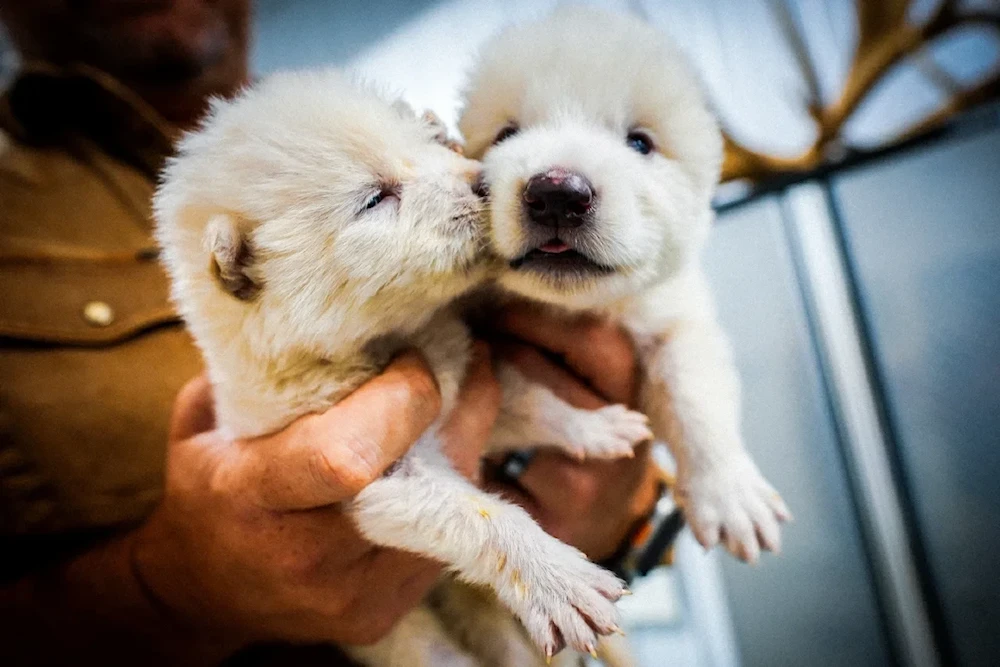Extinct dire wolf revived by biotech firm Colossal Biosciences
Colossal Biosciences has successfully revived the extinct dire wolf using ancient DNA, cloning, and gene-editing, creating three pups that resemble the prehistoric species.
-

A man holds two dire wolf pups born October 1, 2024. (Colossal Biosciences)
Colossal Biosciences, a Dallas-based biotech company, has successfully resurrected the dire wolf, an extinct species that vanished around 10,000 years ago, making it the first animal to be successfully "de-extincted."
Using ancient DNA, cloning, and gene-editing technology, the company created three dire wolf pups by modifying the genes of gray wolves, the closest living relative of the extinct species, the company announced on Monday. "The dire wolf, Aenocyon dirus, is larger in size than gray wolves and “had a slightly wider head, light thick fur and stronger jaw,” the company said.
The new pups are essentially a hybrid resembling the prehistoric dire wolf in appearance, which inspired the wolves in the HBO series, "Game of Thrones."
The three dire wolves are living on a 2,000-acre site at an undisclosed location enclosed by 10-foot-tall (3-meter-tall) “zoo-grade” fencing, where they are monitored by security personnel, drones, and live camera feeds. Colossal said the facility had been certified by the American Humane Society and registered with the US Department of Agriculture.
SOUND ON. You’re hearing the first howl of a dire wolf in over 10,000 years. Meet Romulus and Remus—the world’s first de-extinct animals, born on October 1, 2024.
— Colossal Biosciences® (@colossal) April 7, 2025
The dire wolf has been extinct for over 10,000 years. These two wolves were brought back from extinction using… pic.twitter.com/wY4rdOVFRH
Colossal Biosciences has raised at least $435 million since the company was founded in September 2021, and has been working on various de-extinction projects, including the mammoth, the dodo, and the Tasmanian tiger. Efforts to resurrect the first woolly mammoth calves are on track for 2028.
According to Ben Lamm, Colossal’s CEO, the creation of the dire wolf pups proves the effectiveness of the company's de-extinction technology. “This massive milestone is the first of many coming examples demonstrating that our end-to-end de-extinction technology stack works,” he said.
The science
Using DNA extracted from a 13,000 year old tooth and a 72,000 year old skull, scientists recreated two high-quality dire wolf genomes (or complete sets of genetic information) and used the information from genetic analysis to alter gray wolf cells, making 20 edits in 14 genes before cloning the most promising cell lines and transferring them into donor eggs, according to the news release.
In the genetic analysis, the team compared the genomes with those of canids such as wolves, jackals, and foxes to identify genetic variants for traits specific to dire wolves, such as white coats and longer, thick fur.
“Healthy developing embryos were then transferred into surrogates for interspecies gestation,” with three pregnancies that led to births, Colossal revealed in its statement. The company used domestic large, mixed-breed hounds as surrogates.
Two male dire wolf pups were born on October 1, 2024, while a female pup was born on January 30, 2025, according to Colossal Biosciences.
We’re Colossal Biosciences, the de-extinction company responsible for bringing back the first animals from extinction. Our dire wolf pups, Romulus and Remus, were born on October 1, 2024. Watch these pups grow up on our YouTube channel. Link in bio.
— Colossal Biosciences® (@colossal) April 7, 2025
These two wolves were… pic.twitter.com/hbk1wFQ3lf
The de-extinction process used CRISPR technology to essentially create a hybrid genome to cut away certain gray wolf gene variants and replace them with traits associated with dire wolves, said Love Dalén, a professor in evolutionary genomics based at the Centre for Palaeogenetics at Stockholm University, and an advisor to Colossal.
While these pups are genetically 99.9% gray wolf, Love Dalén notes that they carry the genetic traits of the extinct dire wolf, giving them its characteristic appearance.
“It carries dire wolf genes, and these genes make it look more like a dire wolf than anything we’ve seen in the last 13,000 years. And that is very cool.”, Dalén said.
The company aims to use this technology to help endangered species, having already cloned critically endangered red wolves using the same methods. Critics, however, question the ethical implications and environmental impact of de-extinction, especially regarding the role these creatures could play in today’s ecosystems.
Gene-editing technologies have been leveraged to address various health challenges. Researchers can utilize CRISPR gene editing to eliminate HIV from infected cells, offering potential pathways for curing the disease. Scientists have also collaborated to rewrite DNA to provide remedies for genetic heart diseases. Gene editing has also aided in finding a cure for Batten disease through gene-edited sheep.

 4 Min Read
4 Min Read








